Conservation
Xylophis captaini was described in 2007. Much is still unknown about its ecology, especially its population biology and reproduction, making it difficult to determine its precise conservation status and requirements.
Since the snake can be found readily in at least low intensity agricultural settings (including gardens), it can withstand at least moderate human disturbance. Therefore it is unlikely to be immediately under great threat if these habitats are maintained.
